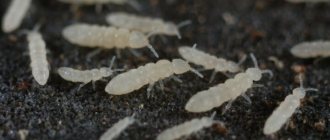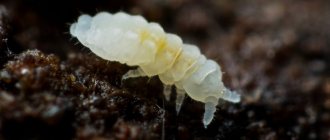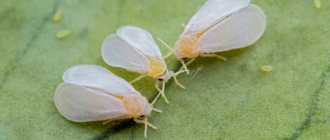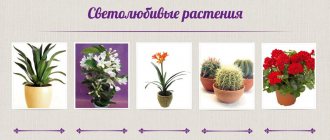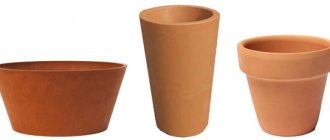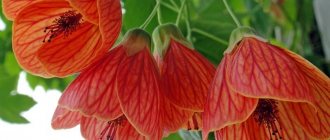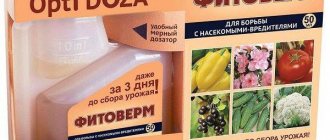Podury: photo
Fools: photo.
Prevention measures
In order not to provoke the proliferation of fools in the garden or in the greenhouse, it is enough to comply with the requirements for moisture content in the soil. Excessive watering and lack of ventilation are the main provoking factors for the onset of favorable conditions for a comfortable life for parasites.
Do you carry out prevention against foolishness?
Of course! No, but I will!
An effective preventive measure is to water the soil before planting plants with a solution of potassium permanganate. This will help destroy the larvae existing in the soil and prevent their further reproduction. You can also water the soil with hot (80 - 90 degrees) water before sowing or planting seedlings.
One of the provoking factors for the reproduction of fools is an excess of nitrogen in the soil. Wet humus or manure is an ideal environment for feeding insects. Therefore, their content in the soil should not be higher than normal.
Reproduction of poduras is the first signal of a violation of agricultural technology for plant care. If you notice insects, you should reconsider your approaches to watering. Otherwise, there is a risk of destruction of the plantings.
Description of the pest
Name: Real fools Lat.:
PoduridaeClass: Springtails - Collembola Order: Springtails - Poduromorpha
| Habitats: | indoor plants, garden and vegetable garden |
| Dangerous for: | colors |
| Means of destruction: | Fufanol, chemicals, decoctions |
Podura: photo.
Poduras are similar to small caterpillars. Color white or cream. Very rarely they are greenish or silvery. Body length is about 2 mm. Sometimes the length reaches 1 cm. The body has an oval shape.
Thanks to a special fork, they jump perfectly, pushing off with its help. This is what distinguishes the insect from the mealybug. When at rest, the organ is hidden under the abdomen.
The eggs are round in shape. The color is greenish-yellow with shine. After laying, larvae identical to adult individuals appear within 18–20 days. The larvae pose the same danger to flowers as the adults.
Very often, fools are confused with springtails, which live in indoor plants. In order not to be confused, we will continue to consider insects and pests of indoor plants.
Preventive actions
To prevent podurs from appearing in pots (or from re-inoculating), it is necessary to maintain optimal temperature and humidity parameters. Perhaps this is the main preventive measure.
It is also worth paying attention to the following points:
- It is better to purchase new plants in trusted stores and nurseries;
- the condition of the plants and substrate in pots must be carefully monitored;
- do not overdo it with fertilizing, provide the plants with a period of rest;
- dead parts of plants must be promptly removed and the soil loosened;
- create proper drainage in flower pots, prevent moisture from stagnating in the pot or tray;
- select a pot (plant pot) in accordance with the size of the root system;
- periodically carry out preventive treatments with herbal insecticides and growth stimulants in order to improve plant health and increase resistance to various pests and diseases.
Common types
The parasite population depends on the humidity level. High humidity promotes active reproduction. Among the most common varieties, it is worth highlighting several main ones.
White . Living in the upper layer of the earth. Favorite places are greenhouses and greenhouses.
Vegetable . Eats ornamental crops and garden plants.
Mushroom . It feeds on young vegetative organs of plants and seedlings.
How to get rid of it: effective methods of control
First of all, you need to analyze the circumstances of the appearance of springtails in an apartment or on a personal plot. The main reason is high humidity, both soil and air. Therefore, the main task is to eliminate the causes that attracted the attention of these pests.
The essence of the actions:
- Pay attention to the correct watering of indoor plants, especially if watering for them is not necessary in such volumes.
- It is necessary to get rid of contaminated soil. To do this, you will have to replant the plant, thoroughly washing the root system.
- Start arranging the drainage system and checking its functionality, since often the holes become clogged and the excess moisture has nowhere to go. Particular attention should be paid to this factor during the process of plant transplantation.
- An orchid or other flower, along with its pot, can be placed in a bucket of water for 15 minutes. Insects will definitely float up and end up on the surface of the water. All that remains is to collect the pests and destroy them.
- Humidity in the room should be maintained within optimal limits, for which the room should be ventilated more often, do not dry clothes in the room and provide access to sunlight. If all else fails, you will have to purchase a special device.
- Do not apply organic fertilizers in excess of the norm. It is permissible to feed plants with tea leaves, coffee grounds or fermented milk products no more than once a week, and it is better not to do this at all. After a couple of days, it is better to remove such fertilizer from the pot, as it will begin to rot.
The main condition for using various folk remedies is to bring the humidity level in the home to normal levels.
Folk remedies
There are a number of traditional ways to get rid of such pests. It does not require any scarce or expensive components. For example:
- Potato bait . To do this, just take the root vegetable and cut it into 2 parts. After this, the two halves are laid cut side down. After a few hours, you can see these insects gathering around the potatoes. The owners can only quickly localize the pieces of potato with springtails by covering them with a glass or other object. After this, you need to get the insects out and destroy them. You need to act quickly, since these pests do not stay in one place for long and move quite quickly.
- Use of wood ash . This product reduces the moisture in the top layer of soil, thereby reducing the number of pests. To do this, you need to take the ash and pour a centimeter layer on top of the soil. In this case, you should reduce watering and reduce air humidity. Azaleas and camellias prefer highly acidic soil, so this method is not suitable for them.
Application of chemicals
Not always, folk remedies prepared with natural ingredients help get rid of pests, especially if there are a huge number of them. They suck the juices out of plants, attack the root system, which is why the plants weaken before our eyes and can die if nothing is done.
Therefore, it is very important to get rid of these pests in a timely manner by treating the plants with chemicals.
To treat plants you can use:
- Dimilin . The active ingredient is diflubenzuron, at a concentration of 250 g/kg. A low-toxic, broad-spectrum insecticide that acts as an insect growth regulator. This is a modern drug that remains effective for 40 days. This drug is considered safe for humans and pets. Despite this, personal protective equipment should not be neglected. The product decomposes quickly, both in water and in soil.
- Regent . The active component is fipronil, which causes paralysis in insects due to blocking the transmission of nerve impulses. It has a contact-intestinal effect and destroys all pests in a few days. The drug can be purchased both in ampoules and in powder form. When contacting this substance, precautions should be taken. You shouldn't put your health at risk.
- Bazudin . This is a long-acting drug that can protect plants from many pests. The product has a pungent odor and belongs to the 3rd toxicity class. It is produced in the form of granules, which have a complex effect on plant pests. To combat fools, it is enough to place the granules in the soil to a depth of 1 cm. A day after using the drug, the insects will disappear. They cannot appear again for a month and a half. Another advantage of the substance is that it does not harm plants.
Springtails in a substrate with an orchid. Ways to fight (part 1)
Reasons for the appearance of dupes
A small number of insects are always present in the soil of indoor plants, greenhouses, and especially open areas. They cause harm in large numbers. The appearance of parasites on ornamental plants is associated with:
- high humidity due to disruption of the irrigation system - watering should not be abused;
- increased level of moisture in the room - a damp microclimate contributes to the invasion of insects;
- the development of putrefactive processes - this refers to black tea leaves that rot, and to stagnation of moisture. They need to be removed;
- non-compliance with certain temperatures;
- weakened immune system in a calm state;
- the presence of moss in the container;
- violation of care - fallen leaves rot and attract fungi and parasites.
Why are springtails dangerous for plants and the damage they cause?
The appearance of podura in flowers in small quantities should serve as a signal to gardeners that the plants are being kept in improper conditions. Springtails are herbivorous decomposers, that is, they feed on dead organic matter. At the same time, organic substances decompose into simple chemical compounds, enriching the soil. Their diet at home includes:
- dead above-ground and underground parts of the plant (roots, leaves, etc.);
- moss;
- fungus and mold;
- algae growing on the surface of waterlogged soil.
When there are too many springtails, they may not have enough food, and they begin to eat young shoots and roots of the plant. In conditions of excess humidity this can lead to:
- rotting;
- weakened immunity;
- development of diseases (viral and microbial).
Development of the disease
Rules for using chemicals
Chemicals also cannot be called a cure for all diseases, and they are by no means safe for the environment. Their use is justified only for especially valuable plants, when all other, more gentle, means have already been exhausted.
- You should always strictly follow the manufacturer's instructions and under no circumstances use chemicals intended to protect plants outdoors indoors.
- Chemical protective equipment should only be stored in places inaccessible to children and pets. Handle residues carefully as they are highly hazardous waste.
- Don’t forget about self-defense, wear gloves and try not to get it in your eyes or inhale the product.
- Do not use products marked with a skull symbol and classified as T+, which means highly toxic, and T, which means poisonous.
- As a last resort, use drugs with a cross sign and the designations Xn, , is poisonous to a small extent, and Xi, is irritating.
- “Of the commercially available plant protection chemicals are not marked with any signs at all, because they are not at all dangerous.
Solutions and infusions for bugs
Use a solution of potassium permanganate to kill bugs on indoor flowers. It is necessary to spray the plants daily for 1 week.
It is important to carry out a water procedure before this. You need to take the plant affected by the bugs and put it under the shower for 10-15 minutes
After a week-long fight against bugs, you will need to leave indoor flowers for three days. After this time, inspect them carefully. If bugs are still present in some areas, treat with potassium permanganate solution 4 more times. After this, the pests will completely disappear.
Calendula tincture is great for getting rid of bugs. It is diluted in warm water in the following ratio 1:5. The prepared solution needs to be sprayed every other day on indoor plants until the pests completely disappear. In case of severe damage to flowers by bugs, you should use tobacco infusion. There is no need to pre-dilute it. It is necessary to spray each indoor plant affected by pests with it three times at weekly intervals. A similar procedure for getting rid of bugs is carried out using garlic infusion.
Insecticidal preparations
Insecticides of contact and systemic spectrum are effective means of controlling pests of plants and flowers. Since their range is quite large, a number of features of some should be considered.
Many gardeners try to avoid the unnecessary use of chemicals due to their toxicity. In fact, they are dangerous only for pests, and not for humans. The degree of toxicity of any composition is determined by the LD50 level, which determines the maximum amount of a substance required to be consumed or inhaled to cause death.
Insecticides against harmful insects, in most cases, are low-toxic and safe for people. They contain only substances harmful to insects. The lethal dosage for humans usually exceeds several hundred grams.
You should not focus on the smell, as most chemicals have a strong and unpleasant smell. Modern drugs are produced without fragrance, but do not lose their effectiveness in killing pests. When choosing a drug for exterminating plant insects, it is better to use different groups in turn: organophosphorus, neonicotinoid, pyrethroid. This technique helps prevent the development of immunity in insects.
Today, an expanded selection of insecticides is available for sale. The most popular drug is "Aktara", endowed with a wide range of damaging effects on plant pests and absolutely harmless to surrounding people.
Available in the form of microencapsulated water-soluble granules. The aqueous solution obtained from them does not emit an unpleasant odor. The advantage of the product is that it is systemic - after application to the plant it accumulates in the tissues for a long period of time, providing protection against parasites for at least 2 weeks.
Progressive chemicals include Apache, which is similar in composition to Aktara. The product is more economical to use.
List of modern chemicals:
- Pegasus;
- Rogor;
- Talstar;
- Fury;
- Arrivo;
- Cypermethrin;
- Talstar.
Biological drugs include:
- Verticillin;
- Mikoafidin.
To help gardeners, there are various sticky traps that are placed near the affected plantings.
No less common in home use are herbal products that have insecticidal and acaricidal effects. These include infusions: red pepper, onion, garlic, tobacco. They are effective against: aphids, scale insects, thrips, mites.
Who is this silverfish?
Common silverfish (also beautifully called “sugar fish”) are usually called small wingless insects belonging to the bristletail order. The size of the insect is less than two centimeters. The flat body, tapering towards the tail, resembles in its shape an elongated triangle or a silvery drop. Thanks to the small silver-gray scales covering the body, the name of the insect in Russian appeared - silverfish. The white elongated silverfish has two long front and three rear antennae that are clearly visible, and short legs are barely visible along the body. Experts note that the insect acquires a light color only after the third molt, and until that time its color is dark gray. The habitat of silverfish in natural conditions is dark and well-moistened areas, under fallen compacted leaves, stones or old snags. Insects that have settled in an apartment or house will select similar living conditions - they definitely will not like a dry and bright room. Unfortunately, a modern bathroom can be considered an ideal place for the appearance of small parasites of all kinds. It is in this room that silverfish most often appear. Interestingly, according to one version, the homeland of this insect is the tropics, so silverfish are looking for a moist, secluded place at a temperature of 21 degrees Celsius. Light frightens these swift tiny creatures; they lead an active lifestyle in the dark, getting out of their hiding places at night. These insects are quite rare in large numbers in the bathroom, usually one or two individuals.
Silverfish prefer to eat products of plant origin, which may contain starch and polysaccharides. This can be flour, sugar, fabrics, paste, paper - often toilet paper. Sometimes silverfish are brought into the house in a roll of toilet paper, into which it could have crawled in the warehouse. Consequently, this insect can pose a danger to carefully stored family photographs, book bindings, wallpaper and various papers. In addition, from organic food, silverfish can consume mold fungi and unicellular algae, small pieces of garbage accumulated under rugs, old rags, etc. For humans, silverfish are completely harmless, they cannot bite, they do not spread pathogenic bacteria, they do not cause harm to health, but they are annoying only by the fact of their presence in the toilet or bathroom and the rare damage to photographs, toilet paper or wallpaper.
Harm
With a small number of parasites, there is practically no serious damage to flowers. If a colony of pests quickly increases, then there is a danger to the growth and development of plants.
Negative effects of springtails:
- under favorable conditions: high humidity, temperatures from + 22 to + 25 degrees, insects multiply quickly, penetrate not only into the soil, but also move to the leaves and stem. Parasites actively suck out juices and gnaw on greens;
- if the root system is damaged, the plant weakens and receives less nutrients;
- affected areas are gateways for the penetration of dangerous microbes. Weakened violets, orchids, and azaleas often suffer from fungal diseases.
